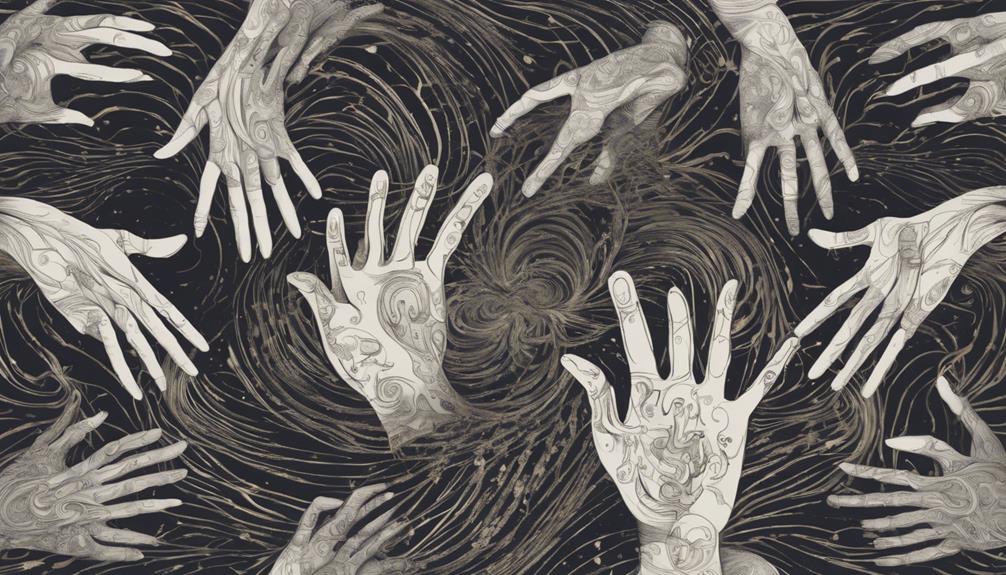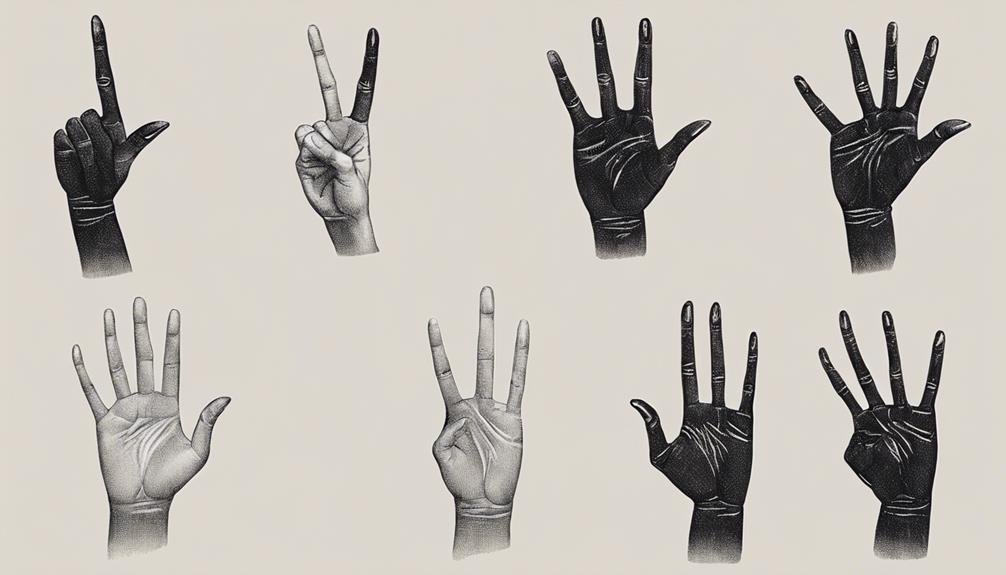Nigerian Sign Language (NSL) is critically important, as it is utilized by over 1 million Deaf individuals in Nigeria on a daily basis. Its significance cannot be overstated.
The intricate blend of handshapes, movements, and facial expressions in NSL offers a rich tapestry of communication unique to the Nigerian Deaf community.
However, the layers of cultural influences, historical evolution, and linguistic nuances that shape NSL's identity are yet to be fully explored.
As we venture into unraveling the mysteries of what makes Nigerian Sign Language truly unique, we are bound to discover a world of expression and connection that transcends mere words.
Key Takeaways
- Incorporates Yoruba gestures and linguistic connections, enriching its cultural roots.
- Utilizes unique handshapes and movements tailored to the Deaf community's experiences.
- Reflects diverse cultural influences and traditions within Nigeria, showcasing its rich heritage.
- Regional variations and community integration enhance communication, fostering unity and understanding.
Cultural Influences
Incorporating Yoruba gestures and linguistic connections, Yoruba Sign Language uniquely reflects the cultural influences of the Yoruba-speaking communities. The utilization of Yoruba gestures as signs in this form of sign language showcases a deep-rooted connection to the rich cultural heritage of the Yoruba people. One distinctive feature is the mouthing of Yoruba words, which not only enhances the linguistic connection but also serves as a visual representation of the Yoruba language within the signing process.
Moreover, the presence of local signs within Yoruba Sign Language further underscores its unique cultural foundation. These signs aren't arbitrary but are deeply entrenched in the expressions of the Yoruba culture, making the language a true reflection of the community it represents. It's important to note that this emphasis on cultural influences sets Yoruba Sign Language apart from Nigerian Sign Language, as it's distinctively grounded in the gestures and expressions specific to the Yoruba culture.
Unique Gestures

Reflecting the vibrant tapestry of Nigerian culture, the unique gestures found in Nigerian Sign Language intricately intertwine with the diverse traditions and customs of the nation. These gestures aren't only a means of communication but also a reflection of the cultural and linguistic influences that shape Nigerian Sign Language.
Here are five key characteristics of the unique gestures in Nigerian Sign Language:
- Cultural Embeddedness: The hand movements and facial expressions used in Nigerian Sign Language are deeply rooted in Nigerian cultural nuances and local customs.
- Specificity to Deaf Community: The gestures in Nigerian Sign Language are tailored to the experiences and expressions of the Deaf community in Nigeria, making them distinct and meaningful.
- Distinct Meanings: Each gesture in Nigerian Sign Language conveys meanings and concepts that are specific to the cultural context of Nigeria, setting it apart from other sign languages.
- Rich Diversity: The gestures in Nigerian Sign Language reflect the rich diversity of Nigerian traditions, showcasing a wide array of movements and expressions.
- Uniquely Nigerian: These gestures are a unique form of communication that embodies the essence of Nigerian identity and heritage, making Nigerian Sign Language a truly distinct language.
Regional Variations
The diversity of local cultures and languages within Nigeria is reflected in the regional variations present in Nigerian Sign Language, evident in the distinct signs, gestures, and facial expressions across different parts of the country. These regional differences in Nigerian Sign Language encompass various aspects, including unique handshapes, movements, and non-manual markers that are specific to particular areas. Local dialects and linguistic influences further contribute to the richness of these regional variations, shaping the way deaf individuals communicate within their communities.
In some regions, specific signs and gestures may hold particular meanings or nuances that aren't present in other parts of the country. Facial expressions, an integral part of sign language communication, also exhibit regional diversity, influenced by the cultural norms and practices of the local population. Understanding these regional variations is crucial for effective communication and fostering cultural appreciation within the Nigerian deaf community.
Historical Development

We can trace the historical development of Nigerian Sign Language back to its origins and evolution from indigenous sign languages in Nigeria.
The influences on its formation are deeply rooted in local gestures, expressions, and the diverse communication needs within the deaf community.
Understanding this historical context sheds light on the unique features and characteristics that distinguish Nigerian Sign Language.
Origin and Evolution
Rooted in Nigeria's rich cultural tapestry and linguistic diversity, the evolution of Nigerian Sign Language showcases a unique journey shaped by indigenous influences and community resilience.
Indigenous signs and gestures from various Nigerian languages likely played a significant role in the formation and growth of Nigerian Sign Language. The historical development of Nigerian Sign Language highlights the adaptability and perseverance of the deaf community in Nigeria over time.
Factors such as historical events, social dynamics, and linguistic influences have all contributed to shaping the distinct characteristics of Nigerian Sign Language. This evolution has led to the creation of a language that isn't only a mode of communication but also a reflection of the diverse cultural heritage of Nigeria.
- Indigenous signs and gestures from various Nigerian languages
- The adaptability and perseverance of the deaf community
- Historical events shaping the language
- Social dynamics influencing the evolution
- Linguistic influences contributing to distinct characteristics
Influences on Formation
Influenced by a rich tapestry of indigenous Nigerian cultures, particularly the Yoruba culture, Nigerian Sign Language (NSL) has intricately woven historical interactions and exchanges within Nigerian communities into its unique features and characteristics.
The formation of NSL reflects the diverse cultural influences present in Nigeria, encompassing local gestures, linguistic elements, and social norms specific to different regions. Over time, the language has evolved, incorporating indigenous practices and beliefs, which have contributed to its distinctiveness.
The historical evolution of NSL showcases the cultural diversity within Nigerian communities and the ways in which these interactions have shaped the language. By embracing the heritage of various Nigerian cultures, NSL has developed into a language that embodies the spirit and history of the nation.
Linguistic Features

We observe that handshape variations and facial expressions play a crucial role in conveying nuanced meanings in Nigerian Sign Language.
These elements combine to create a rich tapestry of communication, allowing for intricate expressions and emotions to be accurately portrayed.
Understanding the intricate dance between handshapes and facial cues is key to unraveling the linguistic depth of Nigerian Sign Language.
Handshape Variations
Among the distinctive linguistic features of Nigerian Sign Language are the intricate handshape variations that play a fundamental role in conveying precise meanings and facilitating effective communication. These handshape variations include:
- Representing various concepts, such as time or size, through specific hand configurations.
- Depicting objects by mimicking their shapes or characteristics with handshapes.
- Expressing actions like running or eating using different hand configurations.
- Describing attributes or qualities of objects and individuals through specific handshapes.
- Interacting with parameters like movement, location, and facial expressions to enhance the meaning conveyed through handshapes.
Understanding and mastering these handshape variations is crucial for proficient and nuanced signing in Nigerian Sign Language.
Facial Expressions
Facial expressions in Nigerian Sign Language intricately convey grammatical information and emotions, essential for distinguishing between various types of statements and commands. These expressions serve as non-manual markers that accompany manual signs, enriching communication and adding layers of meaning.
In Nigerian Sign Language, facial expressions are meticulously used to differentiate between questions, statements, and commands, contributing to the uniqueness of this sign language. The wide array of facial expressions employed in Nigerian Sign Language enhances the clarity and precision of signs, making the language more nuanced and expressive.
Understanding the subtleties of these facial expressions is key to mastering Nigerian Sign Language and fully grasping the intricacies of its grammar and communication style.
Community Integration

Promoting social inclusion and fostering communication within the deaf community, Nigerian Sign Language plays a crucial role in enhancing community integration among deaf individuals in Nigeria. Through its unique features and widespread use, NSL contributes significantly to the social fabric of the deaf community, creating a sense of unity and belonging.
- Cultural Heritage: NSL connects deaf individuals with their cultural heritage and identity, providing a means to express cultural nuances and traditions.
- Events: Community events and gatherings often feature NSL as a primary mode of communication, allowing for seamless interaction among attendees.
- Relationships: NSL enhances relationships within the deaf community, fostering deeper connections and understanding among individuals.
- Expression: NSL enables deaf individuals to express themselves fully, contributing to a more inclusive and communicative environment.
- Unity: By serving as a common language, NSL promotes unity and solidarity among deaf individuals, strengthening the community as a whole.
Educational Practices

Integrating Nigerian Sign Language into educational practices enhances learning outcomes for deaf students through specialized programs and sign language as the primary mode of instruction. Educational institutions in Nigeria recognize the importance of incorporating Nigerian Sign Language into curricula to promote effective communication and academic success among deaf learners. Sign language interpreters play a vital role in facilitating smooth communication within educational settings, ensuring that deaf students have equal access to information.
To emphasize the significance of educational practices in deaf education, consider the table below:
| Aspects of Educational Practices for Nigerian Sign Language | Description | Importance |
|---|---|---|
| Specialized Programs | Tailored curriculum for deaf students | Enhances learning outcomes |
| Primary Mode of Instruction | Sign language as the main teaching medium | Facilitates comprehension and participation |
| Communication Facilitation | Sign language interpreters aid in communication | Ensures effective interaction |
Impact on Deaf Culture

Nigerian Sign Language serves as a cornerstone in upholding and enriching the cultural heritage of the deaf community in Nigeria. Through the lens of deaf culture, Nigerian Sign Language has a profound impact that goes beyond mere communication.
Here are five ways it influences the deaf cultural landscape:
- Expressing Identity: Nigerian Sign Language allows deaf individuals to express their cultural identity through unique signs and gestures that are specific to their community.
- Fostering Belonging: By facilitating communication, Nigerian Sign Language fosters a sense of belonging among deaf people, creating a tight-knit community.
- Preserving Traditions: Through the use of Nigerian Sign Language, traditions and values are passed down from generation to generation within the deaf community.
- Enhancing Pride: The ability to communicate using Nigerian Sign Language enhances the pride of deaf individuals in their cultural heritage.
- Strengthening Community Bonds: Communication in Nigerian Sign Language strengthens the bonds within the deaf community, creating a supportive network for its members.
Frequently Asked Questions
What Kind of Sign Language Is Used in Nigeria?
In Nigeria, the primary sign language used by deaf individuals is Nigerian Sign Language (NSL). NSL incorporates unique handshapes, movements, and facial expressions to convey meaning effectively.
It's essential for communication, education, and cultural identity within the deaf community. NSL has various regional variations and dialects, reflecting the linguistic diversity of Nigeria.
Efforts to promote and preserve NSL through advocacy and training programs are ongoing to support the deaf community.
What Are the Unique Features of Sign Language?
When considering unique features of sign language, one must explore the intricate blend of handshapes, movements, and facial expressions that enhance communication. Regional variations and dialects further enrich the language, shaping its diversity.
Fingerspelling seamlessly integrates into sign language, allowing for precise expression. Grammar in sign language thrives on spatial relationships and non-manual markers, setting it apart from spoken languages.
Visual perception plays a vital role in conveying nuanced messages effectively.
Who Brought Sign Language to Nigeria?
Sign language in Nigeria was brought by American and European missionaries and educators. Missionaries like Andrew Foster, along with educators from the School for the Deaf in Lagos, played vital roles in its introduction.
American Sign Language (ASL) heavily influenced sign language implementation due to the backgrounds of these missionaries. Their efforts led to the recognition and adoption of sign language in Nigeria, which eventually paved the way for the development of indigenous sign languages like Nigerian Sign Language.
What Is the Difference Between ASL and Nsl?
The difference between American Sign Language (ASL) and Nigerian Sign Language (NSL) lies in their vocabulary, grammar, and cultural influences. ASL is based on French Sign Language, while NSL incorporates Nigerian culture and indigenous sign gestures.
These distinctions highlight the unique linguistic characteristics and cultural diversity of sign languages. Understanding these differences is vital for effective communication with Deaf individuals in Nigeria.
Conclusion
In conclusion, Nigerian Sign Language (NSL) is a rich and unique communication system that plays a crucial role in preserving the cultural identity of the Deaf community in Nigeria.
Despite facing challenges, such as limited recognition, NSL continues to thrive with over 1 million Deaf individuals relying on it for communication.
This statistic highlights the significance and importance of NSL in the lives of Deaf individuals, underscoring the need for continued support and recognition of this unique language.











